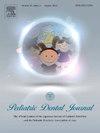Questionnaire survey on oral function during growth periods throughout Japan after the coronavirus disease 2019 pandemic
IF 0.6
Q4 DENTISTRY, ORAL SURGERY & MEDICINE
引用次数: 0
Abstract
Objectives
Systemic and local problems may lead to the disruption of craniofacial growth and development during growth periods. However, no studies have demonstrated the negative effects of the coronavirus disease 2019 (COVID-19) on the development of oral function in children. In this study, we aimed to investigate whether the COVID-19 pandemic has influenced the development of oral function in children.
Materials and methods
The study participants comprised children who visited public or 58 private dental clinics after the COVID-19 pandemic. The questionnaire comprised 66 items regarding current medical conditions and lifestyle habits that are linked to oral function. The survey was a self-administered questionnaire or a web-based questionnaire using Google Forms.
Results
Compared to our 2014 survey (Nogami et al., 2014), the results of 599 children (282 boys and 317 girls; aged 3–12 years; mean age, 7.8 years, standard deviation, 2.4 years) who were included in the study showed a remarkable increase in their responses for the following questions: “Difficulty maintaining nasal breathing for more than a minute with one's mouth closed,” “incompetent lip seal,” “round shoulders,” “thick lips,” “dry lips,” “chapped lips,” “morning breath,” “inverted V-shaped upper lip,” “loose lips,” and “frequent dry mouth.”
Conclusion
Systemic and local problems can be categorized into four factors, namely (1) poor sleep habits, (2) commonly observed eating habits, (3) nasal disorders, and (4) general motor functions. Evident from the current study, the COVID-19 pandemic has negatively affected the systemic and oral health of children.
2019冠状病毒病大流行后日本各地生长期口腔功能问卷调查
目的:全身性和局地性问题可导致生长时期颅面生长发育的中断。然而,没有研究证明2019冠状病毒病(COVID-19)对儿童口腔功能发育的负面影响。在本研究中,我们旨在调查COVID-19大流行是否影响了儿童口腔功能的发展。材料和方法研究对象为在COVID-19大流行后前往公立或58家私立牙科诊所的儿童。调查问卷包括66个项目,内容涉及与口腔功能相关的当前医疗状况和生活习惯。该调查是一份自我管理的问卷或使用谷歌表单的基于网络的问卷。结果与我们2014年的调查(Nogami et al., 2014)相比,599名儿童(282名男孩和317名女孩;3-12岁;平均年龄7.8岁,标准差2.4岁),在以下问题上的回答显著增加:“闭着嘴保持鼻腔呼吸困难超过一分钟”,“嘴唇密封不佳”,“肩膀圆”,“嘴唇厚”,“嘴唇干”,“嘴唇干裂”,“早晨呼吸”,“倒v型上唇”,“嘴唇松弛”和“经常口干”。结论全身性和局部性问题可分为4个因素,即:(1)不良睡眠习惯,(2)常见饮食习惯,(3)鼻功能障碍,(4)一般运动功能。从目前的研究中可以明显看出,COVID-19大流行对儿童的全身和口腔健康产生了负面影响。
本文章由计算机程序翻译,如有差异,请以英文原文为准。
求助全文
约1分钟内获得全文
求助全文
来源期刊

Pediatric Dental Journal
DENTISTRY, ORAL SURGERY & MEDICINE-
CiteScore
1.40
自引率
0.00%
发文量
24
审稿时长
26 days
 求助内容:
求助内容: 应助结果提醒方式:
应助结果提醒方式:


